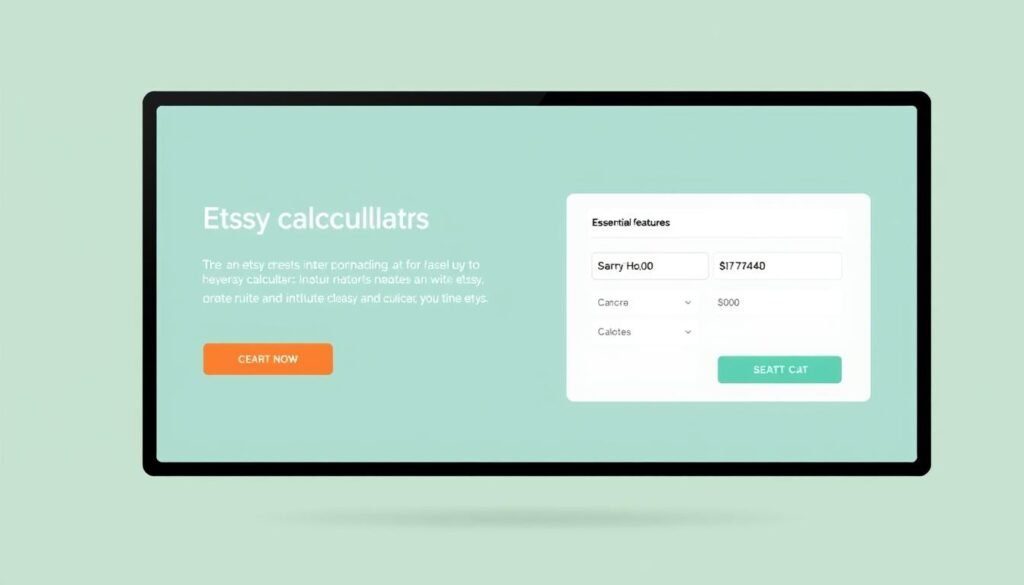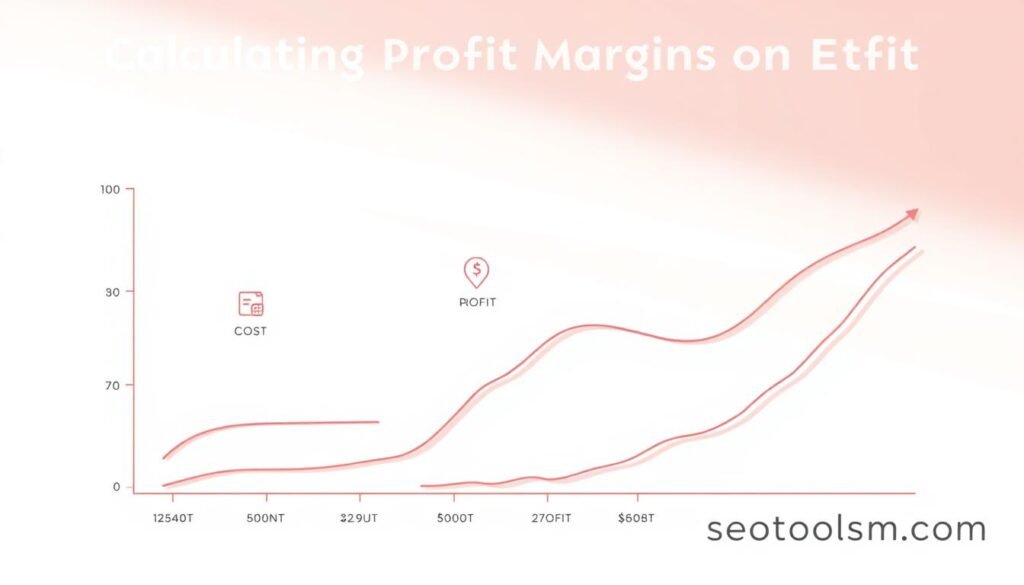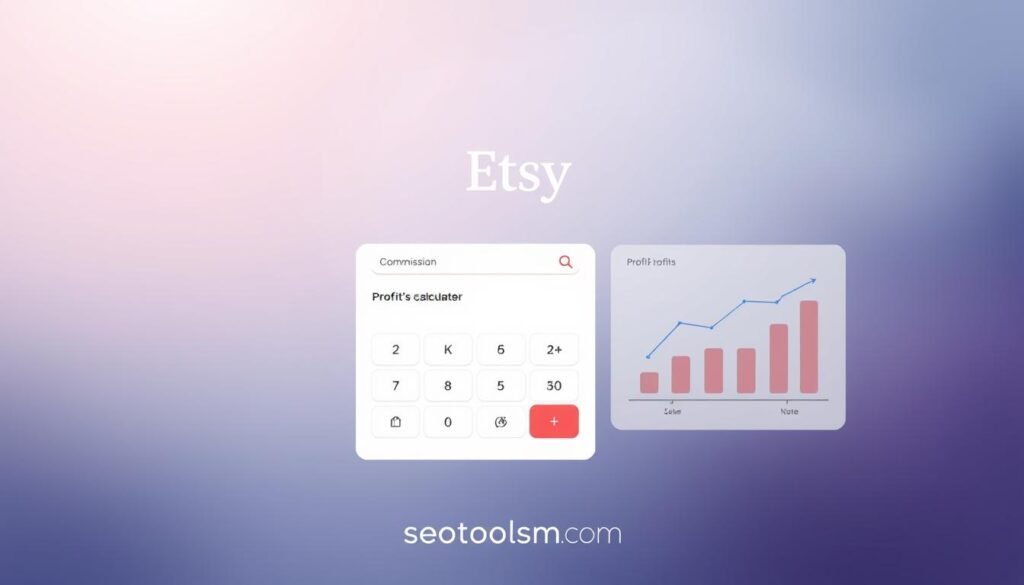As sellers on Etsy, we face the challenge of determining our actual profit after accounting for various fees and costs. Calculating these expenses accurately is crucial for sustainable business growth and proper pricing strategy.
We understand the complexity of managing costs and fees on Etsy, which is why we’ve developed a tool to simplify this process.
Our calculator takes into account all relevant Etsy fees, shipping costs, and product expenses to provide accurate profit projections, enabling sellers to make informed business decisions.
Key Takeaways
- Simplify the process of determining optimal pricing and estimating potential profit.
- Accurately account for all relevant fees and costs associated with selling on Etsy.
- Make informed business decisions with precise profit projections.
- Save time by using our calculator to manage your Etsy business expenses.
- Enhance your pricing strategy for sustainable business growth.
Understanding the Etsy Calculator

Etsy sellers often find themselves juggling various costs, but an Etsy calculator simplifies this complex task. Our Etsy Calculator provides a breakdown of expenses and fees associated with selling on Etsy, saving precious time by automating the Etsy fee calculation process.
What Is an Etsy Calculator?
An Etsy calculator is a specialized tool designed to help sellers accurately calculate all fees associated with selling products on the Etsy platform. It takes into account listing fees, transaction fees, payment processing fees, and other costs to determine actual profit margins.
Why Every Etsy Seller Needs a Fee Calculator
Accurate fee calculation is crucial for Etsy sellers to maintain profitable operations and make informed pricing decisions. By using a fee calculator, sellers can prevent unexpected profit losses and understand the true cost of doing business on Etsy. Even experienced sellers benefit from using a calculator to streamline their financial planning and ensure consistent profitability.
Our Etsy Calculator is designed with a user-friendly interface and comprehensive fee coverage, allowing sellers to test different pricing scenarios to optimize their profit margins without risking actual sales. This functionality is essential for sellers aiming to maximize their profit calculator capabilities and maintain a competitive edge on the platform.
The Complete Breakdown of Etsy Fees
Understanding the fees associated with selling on Etsy is crucial for any seller looking to maximize their profits. As we delve into the specifics, you’ll see that there are several types of fees to consider when selling on the platform.
Listing Fees
Etsy charges a listing fee of $0.20 per item listed, regardless of whether the item sells. This fee renews every four months until the item is sold or removed.
Transaction Fees
A transaction fee of 6.5% is applied to the total sale price, including shipping costs and gift wrapping, if applicable. This fee is charged on every sale made through the platform.
Payment Processing Fees
Payment processing fees vary by region but typically include a percentage plus a fixed amount. For example, in the US, the fee is 3% + $0.25 per transaction.
Additional Fees to Consider
Other fees may apply, such as currency conversion fees (2.5%), regulatory operating fees for certain regions, and optional subscription costs. These fees can compound and impact your final profit margin.
How Etsy Fees Impact Your Profitability
To maintain a healthy Etsy business, you need to grasp how Etsy fees affect your bottom line. The various fees associated with selling on Etsy can collectively impact your profitability, making it essential to understand and manage them effectively.
The Real Cost of Selling on Etsy
Selling on Etsy comes with various costs, including listing fees, transaction fees, and payment processing fees. These costs can add up and significantly reduce your profit margins if not properly accounted for in your pricing strategies.
| Fee Type | Description | Impact on Profit |
|---|---|---|
| Listing Fees | $0.20 per listing | Minimal |
| Transaction Fees | 3.5% of sale price | Moderate |
| Payment Processing Fees | 3% + $0.25 per transaction | Significant |
Why Accurate Fee Calculation Matters
Accurate calculation of Etsy fees allows sellers to set prices that cover all costs while remaining competitive. This is crucial for maintaining healthy profit margins and ensuring sustainable business growth on Etsy. By understanding the difference between total revenue and profit, sellers can make informed decisions about their pricing and sales strategies.
Getting Started with Our Etsy Calculator

Getting started with our Etsy Calculator is straightforward and easy. Our tool is designed to be user-friendly, making it simple for you to manage your Etsy fees.
Accessing the Calculator
To access our Etsy Calculator, simply navigate to our website and click on the calculator tool. No account creation is required, making it easy to get started right away.
Understanding the Interface
The calculator’s interface is clean and intuitive, featuring main input fields and a calculation button. This design ensures easy use for all users, regardless of their technical experience.
Mobile vs. Desktop Experience
Our Etsy Calculator is fully responsive, providing a seamless experience on both mobile and desktop devices. You can bookmark the page on your mobile browser for quick access, eliminating the need for a separate app installation. This tool is designed to work just as well on-the-go as it does on your desktop, making it a versatile Etsy calculator solution.
Step-by-Step Guide to Using the Etsy Calculator
Mastering our Etsy Calculator is key to unlocking your full profit potential on Etsy. To get started, you’ll need to input some basic information about your product.
Entering Your Product Information
Begin by entering your product’s selling price, production cost, and any additional expenses related to creating the product. This information will help us calculate your total costs and potential profit.
Adding Shipping Costs
Next, you’ll need to add your shipping costs, including considerations for different shipping methods, packaging materials, and handling time. Accurate shipping costs are crucial for determining your overall expenses.
Reviewing Your Results
Once you’ve entered all the necessary information, review your calculation results. You’ll see a breakdown of various fees, including listing fees, transaction fees, and processing fees, as well as your total cost and profit. Use this information to test different pricing scenarios and find the optimal price point for maximizing your profits while remaining competitive.
By following these steps and regularly using our Etsy Calculator, you can ensure you’re making informed decisions about your product pricing and maintaining a healthy profit margin.
Advanced Features of Our Etsy Calculator
Our Etsy Calculator stands out with its advanced features designed to give sellers a competitive edge. It’s more than just a fee calculator; it’s a comprehensive tool for optimizing your sales strategy.
Breakeven Analysis
Our web app includes a breakeven analysis feature, allowing you to determine the minimum price needed to cover costs and start generating profit. This functionality is crucial for configuring every single scenario given our list of options.
Profit Margin Calculations
The profit margin calculation feature helps you achieve your desired profit percentage by adjusting various pricing factors. This ensures you’re making informed decisions about your product pricing.
International Support
With support for over 40 regions where Etsy Payments is available, our Etsy Calculator works globally. Whether you’re in the US, UK, Canada, Australia, or elsewhere, our calculator automatically adjusts for region-specific fees, currency conversion rates, and regulatory requirements, making it an indispensable tool for international sellers.
Setting the Right Price for Your Etsy Products
Pricing your Etsy products correctly is crucial for balancing profitability and market competitiveness. When considering a listing price, be sure to account for listing fees and the possible transaction fee you’ll need to pay each time you make a sale.
Finding the Sweet Spot for Pricing
The pricing “sweet spot” is where products are priced high enough to ensure good profit margins but low enough to attract buyers. To find this balance, consider your base product costs, shipping, and desired profit margin.
Competitive Pricing Strategies
Different pricing strategies can be employed, such as cost-plus pricing, value-based pricing, and competitive pricing. Each approach has its pros and cons. For instance, aiming for a 40% profit margin can cover Etsy fees and leave room for business growth.
- Research competitor pricing within your niche.
- Factor in perceived value and product uniqueness.
- Adjust prices seasonally or for special promotions.
Calculating Profit Margins on Etsy
Understanding profit margins is crucial for Etsy sellers to ensure their business remains profitable. Profit margin represents the difference between the sales revenue and the costs associated with producing and selling your products. On Etsy, calculating profit margins involves considering various fees charged by the platform, including listing fees, transaction fees, and payment processing fees.
To accurately determine your profit margin, you need to account for all direct and indirect costs associated with your products, from production to shipping. This includes the cost of materials, labor, packaging, and shipping, as well as Etsy’s fee structure.

What Is a Healthy Profit Margin?
A healthy profit margin varies based on the type of products you sell, production costs, and market conditions. Generally, a profit margin of 40% is considered sustainable for many Etsy businesses, as it allows you to cover all associated fee and retain earnings from your sales. This benchmark can serve as a starting point for your business.
Adjusting Your Margins for Different Products
Different products have different cost structures and market demands, necessitating adjustments in profit margins. For instance, handmade products with high labor costs may require higher margins compared to digital downloads. By understanding these dynamics, you can adjust your pricing strategy to maintain healthy profit margins across your product range.
Region-Specific Fee Considerations
Etsy’s fee structure varies significantly based on the seller’s geographical location. This variation affects the profitability of your Etsy shop, making it crucial to understand the fees associated with your region.
US-Based Sellers
For US-based sellers, the transaction fee has been raised to 6.5% as of April 11, 2022. The payment processing fee is typically 3% + $0.25 USD per transaction. Understanding these fees is key to accurately calculating your profit margins.
International Sellers
International sellers face additional considerations, including currency conversion fees and varying payment processing fees. For instance, many European sellers are charged 4% + €0.30 per transaction. Etsy’s currency conversion involves a 2.5% conversion fee when the sale currency differs from the seller’s bank account currency.
| Region | Transaction Fee | Payment Processing Fee |
|---|---|---|
| US-Based | 6.5% | 3% + $0.25 USD |
| International (Example: Europe) | Varies | 4% + €0.30 |
Accounting for Optional Etsy Fees
To optimize your Etsy business, it’s vital to comprehend the various optional fees available and how they affect your earnings. These fees can significantly impact your profitability, and understanding them is key to making informed decisions about your shop.

Etsy Ads Fees
Etsy Ads allow sellers to promote their listings within Etsy’s search results and other pages. The fee depends on your daily budget set in your store settings, giving you control over your advertising spend.
Offsite Ads Fees
The Offsite Ads program advertises your listings on external sites, including Google’s display network. Sellers who made over $10,000 in the previous year are charged a 12% fee, while others can opt-in at 15%, with a $100 maximum per order.
Subscription Fees
Etsy offers a Etsy Plus subscription for $10/month, providing benefits like listing credits, advanced shop customization, and more. This subscription can enhance your shop’s visibility and functionality.
By understanding these optional fees, sellers can better manage their expenses and adjust their pricing strategies accordingly. Our Etsy Calculator allows you to include or exclude these fees to see their impact on your profitability.
Integrating Print-on-Demand with Your Etsy Shop
By integrating print-on-demand services, Etsy sellers can minimize upfront costs and maximize profitability. This approach allows for a diverse range of products without holding inventory.

Benefits for Sellers
Using print-on-demand services offers several key benefits, including zero inventory costs and reduced upfront investment. It also enables sellers to expand their product offerings without additional production capabilities.
Calculating POD Costs
When using print-on-demand services, their quoted prices typically include the base product cost, printing, and fulfillment. However, shipping costs are often excluded. To accurately determine profitability, enter the quoted price into the item cost field in our Etsy Calculator.
Popular print-on-demand services like Printify and Printful integrate well with Etsy, offering various pricing structures. Sellers should consider these costs when pricing their POD products on Etsy.
Tax Considerations for Etsy Sellers
As an Etsy seller, understanding the tax implications of your sales is crucial for maintaining profitability. Tax obligations can vary significantly depending on your location and the nature of your business.
Sales Tax and VAT
In the United States, Etsy automatically collects and remits sales tax on behalf of sellers in most states. This means that while the buyer pays the sales tax, it can still indirectly affect your profit margins because the total sale amount, including sales tax, is used in calculating payment processing fees. For international sellers, particularly those in regions like the UK, EU, Canada, Australia, and New Zealand, a Value Added Tax (VAT) may apply not only to sales revenue but also to the fees paid to Etsy.
Including Tax in Your Calculations
Our Etsy Calculator allows you to account for tax considerations by entering applicable tax rates. This feature helps you understand how tax impacts your net profit. It’s essential to differentiate between sales tax (paid by buyers) and income tax (paid by sellers on their profits), keeping accurate records for tax reporting purposes.
Consulting with a tax professional is advisable to ensure compliance with varying tax regulations and to explore strategies for reclaiming VAT on business expenses where permitted.
Common Mistakes When Calculating Etsy Fees
Understanding and accurately calculating Etsy fees is essential for sellers to avoid financial missteps. Many sellers make avoidable errors that can significantly impact their profitability.
Overlooking Hidden Fees
Sellers often overlook hidden fees such as payment processing fees, currency conversion fees, and regulatory operating fees. These fees can lead to significant profit miscalculations if not properly accounted for.
Forgetting About Currency Conversion
Forgetting about currency conversion costs can be a costly mistake. When selling to international customers or operating a shop in a currency different from the seller’s bank account, a 2.5% fee can apply.
Other common mistakes include not accounting for Offsite Ads fees, which can be substantial (12-15% of the order value) and mandatory for sellers earning over $10,000 annually. Incorrectly calculating shipping costs or failing to update them as carrier rates change can also erode profits.
| Common Mistake | Description | Impact |
|---|---|---|
| Overlooking Hidden Fees | Ignoring fees like payment processing and currency conversion | Significant profit miscalculations |
| Forgetting Currency Conversion | Not accounting for 2.5% conversion fee on international sales | Reduced profitability |
| Not Accounting for Offsite Ads Fees | Ignoring mandatory fees for sellers earning over $10,000 annually | Substantial additional costs |
| Incorrect Shipping Costs | Failing to update shipping costs as carrier rates change | Eroded profits |
If you notice that Etsy seller fees have changed or if you notice a major miscalculation or error, feel free to direct message us on Twitter and let us know.

By being aware of these common mistakes, Etsy sellers can better manage their finances. Using our Etsy Calculator can help systematically account for all applicable costs and fees, ensuring accurate profitability calculations.
Tips for Maximizing Profitability on Etsy
To maximize profitability on Etsy, sellers need to go beyond accurate fee calculation. We will explore several strategies that can help Etsy sellers boost their profitability.
Optimizing Your Shipping Strategy
Optimizing shipping involves using calculated shipping or flat-rate shipping, offering free shipping on orders over a certain threshold, and utilizing Etsy’s shipping labels for discounted rates, which can significantly reduce shipping costs and enhance customer satisfaction.
Bundle Pricing Strategies
Bundle pricing can increase average order value by offering customers perceived value, resulting in more efficient fee utilization per transaction. This strategy can be particularly effective for sellers with multiple related products.
When to Offer Discounts
Offering discounts can drive sales without unnecessarily sacrificing profit margins. Strategies include seasonal promotions, quantity discounts, and loyalty rewards. Effective discounting requires careful consideration of your cost structure and market conditions.
By implementing these strategies, Etsy sellers can enhance their overall business performance. For instance, conducting market research on specific products ensures competitive pricing. Additionally, optimizing inventory management reduces costs and improves cash flow, particularly for sellers with physical products.
| Strategy | Description | Benefit |
|---|---|---|
| Optimized Shipping | Using calculated or flat-rate shipping and Etsy’s shipping labels | Reduced shipping costs and enhanced customer satisfaction |
| Bundle Pricing | Offering multiple related products at a discounted price | Increased average order value and efficient fee utilization |
| Strategic Discounts | Seasonal promotions, quantity discounts, and loyalty rewards | Driven sales without sacrificing profit margins |
Real-World Examples: Etsy Calculator in Action
Let’s explore how the Etsy Calculator works in real-world scenarios to optimize pricing and profitability for different product types. By examining various case studies, we can understand how to effectively use the calculator.
Case Study: Handmade Jewelry
For a handmade jewelry seller, the Etsy Calculator helps determine the price of a necklace by considering the cost of materials ($10), production time valuation ($15), and shipping ($5). If the selling price is $45, the calculator reveals the total fees ($3.25 transaction fee + $0.20 listing fee + $2.07 payment processing fee) and calculates the profit as $24.48.
Case Study: Digital Downloads
For digital download sellers, the calculator assesses the product price and development cost. If a digital art piece is priced at $20 with a development cost of $5, the Etsy fees ($1.45 transaction fee + $0.20 listing fee + $1.30 payment processing fee) are calculated, resulting in a profit of $11.95.
Conclusion: Taking Control of Your Etsy Business Finances
By leveraging the Etsy Calculator, you can simplify your pricing process, reduce uncertainty, and focus on growing your Etsy business. Understanding all Etsy fees and their impact on your profit is crucial for long-term success on the platform.
Our Etsy Calculator empowers you to take control of your business finances through accurate fee calculation and profit projection for your products. Regularly reviewing and adjusting your pricing strategies as your business grows or Etsy updates its fee structure is essential.
Start using the Etsy Calculator today to optimize your shop’s pricing and improve overall business performance. With proper financial planning and pricing strategy, you can transform your Etsy hobby into a sustainable business.
FAQ
How do I calculate my total revenue on Etsy?
To calculate your total revenue, we need to consider the sale price of your item, shipping costs, and any applicable taxes. Our tool helps you factor in these elements to determine your overall revenue.
What fees are associated with selling on Etsy?
As sellers, we incur various fees, including listing fees, transaction fees, and payment processing fees. Understanding these fees is crucial to maintaining a healthy profit margin.
How do I determine the cost of an item on Etsy?
To determine the cost of an item, we consider the production cost, material costs, and time invested. We can then use our tool to factor in these costs and calculate our profit margin.
Can I use the Etsy fee structure to set competitive prices?
Yes, by understanding the fee structure, we can set prices that balance our profitability with competitive market rates, ensuring we attract customers while maintaining our margins.
How do shipping costs impact my profitability on Etsy?
Shipping costs directly affect our profitability. We need to factor these costs into our pricing strategy to maintain healthy margins and avoid losses.
What is a healthy profit margin for Etsy sellers?
A healthy profit margin varies depending on the product, market conditions, and business goals. Generally, a margin between 15% to 30% is considered viable for many Etsy sellers.
How do I adjust my pricing for different products on Etsy?
To adjust pricing, we analyze the production costs, market demand, and competition for each product. This helps us set prices that are both competitive and profitable.
Are there any additional fees I should be aware of as an Etsy seller?
Yes, additional fees may include Etsy Ads fees, Offsite Ads fees, and subscription fees. Understanding these fees helps us plan and adjust our pricing and marketing strategies accordingly.
How do I calculate my profit margin when selling on Etsy?
To calculate our profit margin, we need to subtract the total costs, including production, shipping, and fees, from the sale price, then divide by the sale price. Our tool simplifies this process.

